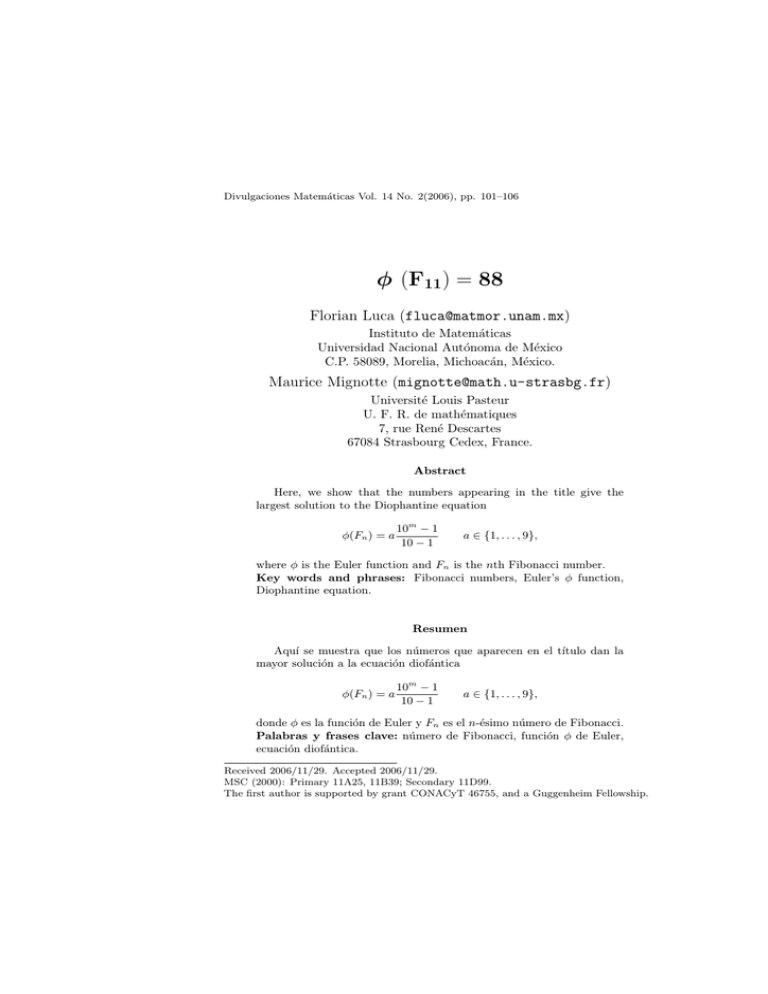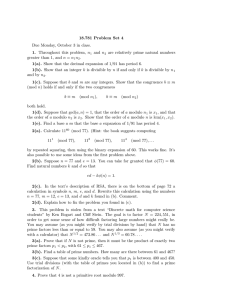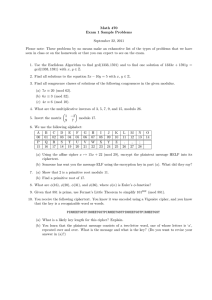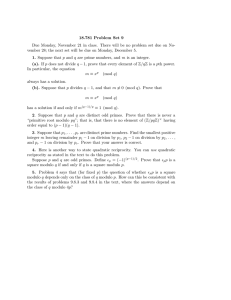φ ) = 88 11 Florian Luca ()
advertisement

Divulgaciones Matemáticas Vol. 14 No. 2(2006), pp. 101–106
φ (F11) = 88
Florian Luca (fluca@matmor.unam.mx)
Instituto de Matemáticas
Universidad Nacional Autónoma de México
C.P. 58089, Morelia, Michoacán, México.
Maurice Mignotte (mignotte@math.u-strasbg.fr)
Université Louis Pasteur
U. F. R. de mathématiques
7, rue René Descartes
67084 Strasbourg Cedex, France.
Abstract
Here, we show that the numbers appearing in the title give the
largest solution to the Diophantine equation
φ(Fn ) = a
10m − 1
10 − 1
a ∈ {1, . . . , 9},
where φ is the Euler function and Fn is the nth Fibonacci number.
Key words and phrases: Fibonacci numbers, Euler’s φ function,
Diophantine equation.
Resumen
Aquı́ se muestra que los números que aparecen en el tı́tulo dan la
mayor solución a la ecuación diofántica
φ(Fn ) = a
10m − 1
10 − 1
a ∈ {1, . . . , 9},
donde φ es la función de Euler y Fn es el n-ésimo número de Fibonacci.
Palabras y frases clave: número de Fibonacci, función φ de Euler,
ecuación diofántica.
Received 2006/11/29. Accepted 2006/11/29.
MSC (2000): Primary 11A25, 11B39; Secondary 11D99.
The first author is supported by grant CONACyT 46755, and a Guggenheim Fellowship.
102
Florian Luca, Maurice Mignotte
For a positive integer n let φ(n) be its Euler function. Let (Fn )n≥0 be the
Fibonacci sequence given by F0 = 0, F1 = 1 and Fn+2 = Fn+1 + Fn for all
n ≥ 0. Recall that a positive integer is a rep-digit (in the decimal system) if
it is of the form a(10m − 1)/9 for some digit a ∈ {1, . . . , 9}. Here, we prove
the following result.
Theorem 1. The largest positive integer solution (n, m, a) of the equation
φ(Fn ) = a
10m − 1
10 − 1
a ∈ {1, . . . , 9}
(1)
is (n, m, a) = (11, 2, 8).
Proof. For a positive integer k let µ2 (k) be the order at which 2 divides the
positive integer k. Since (10m − 1)/9 is always odd, we get that if (n, m, a)
satisfy equation (1), then
µ
¶
10m − 1
µ2 (φ(Fn )) = µ2 a
= µ2 (a) ≤ 3.
9
One checks by hand that n = 11 gives the largest solution of equation (1)
when n ≤ 24. Assume now that n > 24. We show that there exists a prime
factor p of Fn such that p ≡ 1 (mod 4). Indeed, let (Lk )k≥0 be the Lucas
sequence given by L0 = 2, L1 = 1 and satisfying the same recurrence relation
Lk+2 = Lk+1 + Lk for all k ≥ 0 as (Fk )k≥0 does. It is well-known that
L2k − 5Fk2 = 4(−1)k .
(2)
If there exists a prime r ≥ 5 dividing n, then Fr is odd and Fr | Fn . Let p
be any prime factor of Fr . Reducing relation (2) with k = r modulo p, we
get L2r ≡ −4 (mod p). Since p is odd, this leads to the conclusion that −1 is
a quadratic residue modulo p; hence, p ≡ 1 (mod 4). Assume now that the
largest prime factor of n is ≤ 3. Note that 32 does not divide n since otherwise
F9 | Fn , therefore µ2 (φ(Fn )) ≥ µ2 (φ(F9 )) = µ2 (φ(34)) = µ2 (16) = 4, which is
impossible. Finally, if n = 2α · 3 or n = 2α , then, since n > 24, we get that
either 12 | n or 32 | n; hence,
µ2 (φ(Fn )) ≥ min{µ2 (φ(F12 )), µ2 (φ(F32 )} = min{µ2 (φ(24 · 32 )),
φ(3 · 7 · 47 · 2207)} = 4,
which is again impossible. Thus, we have shown that there exists a prime
p ≡ 1 (mod 4) which divides Fn . Clearly, p − 1 | φ(Fn ) and so µ2 (p − 1) ≥ 2.
Divulgaciones Matemáticas Vol. 14 No. 2(2006), pp. 101–106
φ(F11 ) = 88
103
This shows that either there exists one other odd prime factor of Fn , let’s call
it q, or p is the only odd prime factor of Fn .
Case 1. There exists an odd prime factor q 6= p of Fn .
Assume that n is odd. Since n is odd, relation (2) with k = n gives
L2n − 5Fn2 = −4. Reducing the above equation modulo both p and q, we
get that L2n ≡ −4 (mod p) and also L2n ≡ −4 (mod q). In particular, −1
is a quadratic residue modulo both p and q, which implies that both p and
q are congruent to 1 modulo 4. Since (p − 1)(q − 1) | φ(Fn ), we get that
4 ≤ µ2 ((p − 1)(q − 1)) ≤ µ2 (φ(Fn )), which is a contradiction. Thus, n = 2m is
even. Write Fn = 2α pβ q γ . It is clear that α ≤ 1, for if not, then 2(p−1)(q−1) |
φ(Fn ), which leads again to the conclusion that µ2 (φ(Fn )) ≥ 4. If α = 1, then
3 | n. In particular, 6 | n. Thus, F6 | Fn , which is impossible because
F6 = 8 = 23 . Hence, α = 0. Note now that F2m = Fm Lm and Fm and
2
Lm are coprime because L2m − 5Fm
= ±4 and both Lm and Fm are odd.
Furthermore, it is easy to see that m is odd. Indeed, assume that m = 2h
is even. Then Fn = F4h = Fh Lh L2h . Relation (2) with k = h together
with the fact that Fh is odd implies that Fh and Lh are coprime. Further,
Fh Lh = F2h , and now relation (2) with k = 2h together with the fact that
F2h is odd gives that F2h and L2h are also coprime. Since h = n/4 > 6, we
get that L2h > F2h > Fh > F6 = 8. This argument shows that Fn has at
least three odd prime factors, and since at least one of them (namely p) is
congruent to 1 modulo 4, we get that µ2 (φ(Fn )) ≥ 4, which is a contradiction.
Hence, m is odd, therefore each prime factor of Fm is 1 modulo 4. Since p ≡ 1
(mod 4) and q ≡ 3 (mod 4), we get that Fm = pβ and Lm = q γ . Since
m = n/2 > 12, it follows, from the known perfect powers in the Fibonacci
and Lucas sequences [1], that β = γ = 1. Thus, Fn = pq. Since clearly a = 8,
equation (1) becomes
8
10m − 1
= φ(Fn ) = φ(pq) = (p−1)(q −1) = pq +1−(p+q) = Fn +1−(p+q),
9
therefore
10m − 1
.
9
Since also pq = Fn , we get that p and q are the two roots of the quadratic
equation
¶
µ
10m − 1
2
x + Fn = 0.
x − Fn + 1 − 8
9
p + q = Fn + 1 − 8
In order for the last equation above to have integer solutions p and q, its
discriminant ∆ must be a perfect square. Computing ∆ modulo 5 we immeDivulgaciones Matemáticas Vol. 14 No. 2(2006), pp. 101–106
104
Florian Luca, Maurice Mignotte
diately get
∆
≡
µ
¶2
10m − 1
− 4Fn
Fn + 1 − 8
9
≡
≡
(Fn + 1 + 8 · 9−1 )2 + Fn (mod 5)
(Fn + 3)2 + Fn = Fn2 + 2Fn + 4 (mod 5).
(mod 5)
Clearly, Fn is not a multiple of 5 because n = 2m, m = n/2 > 12 and Fm and
Lm are both primes (note that F5 = 5). The only value of¿ b ∈ {1, 2, 3, 4}
such that b2 + 2b + 4 is a perfect square modulo 5 is b = 3. Thus, Fn ≡ 3
(mod 5). The sequence (Fk )k≥0 is periodic modulo 5 with period 20 and if
Fn ≡ 3 (mod 5), then n ≡ 4, 6, 7, 13 (mod 20). Since n = 2m is even but not
a multiple of 4, we get that n ≡ 6 (mod 20). Hence, m ≡ 3 (mod 10). Both
(Fk )k≥0 and (Lk )k≥0 are periodic modulo 11 with period 10. Since m ≡ 3
(mod 10), we get that p = Fm ≡ F3 ≡ 2 (mod 11) and q = Lm ≡ L3 ≡ 4
(mod 11). Thus, φ(Fn ) = (p−1)(q−1) ≡ 3 (mod 11). Reducing now equation
(1) modulo 11 we get
3 ≡ 8((−1)m − 1)9−1
(mod 11),
which leads to 27 ≡ 0, −16 (mod 11), which is impossible. This takes care of
Case 1.
Case 2. p is the only odd prime factor of Fn .
Write Fn = 2α pβ . If 2 | Fn , then 3 | n. Put n = 3m. Then Fn = F3m =
2
2
Fm (5Fm
+ 3). One checks easily that gcd(Fm , 5Fm
+ 3) = 1 or 3. If 3 | Fm ,
then 3 6= p (because p ≡ 1 (mod 4)), so Fn is divisible by two distinct primes,
2
which is a contradiction. Thus, 3 - Fm , therefore Fm and 5Fm
+3 are coprime.
2
2
Since 5Fm + 3 is odd, we get that p | 5Fm + 3, which in turn leads to the
conclusion that Fm is a power of 2, which is impossible because m = n/2 > 12
(the largest power of 2 in the Fibonacci sequence is F6 = 8). Thus, α = 0. By
the known perfect powers in the Fibonacci sequence again, we get that β = 1.
Hence, Fn = p, therefore φ(Fn ) = p − 1 = Fn − 1. We thus get the equation
Fn − 1 = a
10m − 1
.
9
Furthermore, since Fn −1 = p −1 is a multiple of 4, we get that a is a multiple
of 4. Thus, a ∈ {4, 8}. When a = 4, we get that
Fn = 4
10m − 1
4 · 10m + 5
+1=
9
9
Divulgaciones Matemáticas Vol. 14 No. 2(2006), pp. 101–106
φ(F11 ) = 88
105
is a multiple of 5; hence, not a prime. Thus, a = 8. We now show that m is
even. Indeed, assume that m is odd. Then 10m ≡ −1 (mod 11) which leads
to the conclusion that the right hand side of equation (1) is congruent to 8
modulo 11. Hence, Fn ≡ 9 (mod 11). The period of the Fibonacci sequence
(Fk )k≥0 modulo 11 is 10. Checking the first 10 values one concludes that
there is no Fibonacci number Fn which is congruent to 9 modulo 11. Hence,
m is even. Since n > 24, we get that Fn > 102 , therefore m ≥ 3. Rewriting
equation (1) as
9Fn − 1 = 8 · 10m ,
(3)
we get that 9Fn −1 ≡ 0 (mod 64). The Fibonacci sequence (Fk )k≥0 is periodic
modulo 64 with period 96. Further, checking the first 96 values one gets that
n ≡ 14, 37, 59 (mod 96). Since n is odd, we get that n ≡ ±37 (mod 96). But
96 is also the period of the Fibonacci sequence modulo 47, and if n ≡ ±37
(mod 96), then Fn ≡ 5 (mod 47). Reducing now equation (3) modulo 47 we
get 44 ≡ 8 · 10m (mod 47), which is equivalent to 29 ≡ (10m/2 )2 (mod 47).
However, this last congruence is false because 29 is not a quadratic residue
modulo 47 as it can be seen since
µ ¶ µ ¶ µ ¶ µ ¶
29
47
18
2
=
=
=
= −1,
47
29
29
29
³ ´
because 29 ≡ 5 (mod 8). In the above calculations, we used pq for the
Legendre symbol of p with respect to q (where q > 2 is prime) and its elementary properties. This takes care of Case 2 and completes the proof of
Theorem 1.
Remark. The argument from the beginning of the proof of Theorem 1 could
be somewhat simplified using a result of McDaniel [3] who showed that if n 6∈
{0, 1, 2, 3, 4, 6, 8, 16, 24, 32, 48}, then Fn has a prime factor which is congruent
to 1 modulo 4. Furthermore, some of the arguments from the proof could also
be simplified if one appeals to the Primitive Divisor Theorem for the Fibonacci
sequence [2], which says that if n > 12, then there exists a prime factor p | Fn
such that p - Fm for any positive integer m < n. We have however preferred
to give a self-contained proof of our Theorem 1 up to the knowledge of perfect
powers in the Fibonacci and Lucas sequence [1]. It would be interesting to
give a completely elementary proof of Theorem 1 (i.e., without appealing to
the results from [1]). We could not succeed in finding such an argument and
we leave this as a challenge to the reader.
Divulgaciones Matemáticas Vol. 14 No. 2(2006), pp. 101–106
106
Florian Luca, Maurice Mignotte
References
[1] Y. Bugeaud, M. Mignotte, S. Siksek, Classical and modular approaches to
exponential Diophantine equations I. Fibonacci and Lucas perfect powers,
Ann. of Math. 163 (2006), no. 3, 969–1018.
[2] R. D. Carmichael, On the numerical factors of arithmetic forms αn ± β n ,
Ann. of Math. 15 (1913), 30–70.
[3] W. McDaniel, On Fibonacci and Pell numbers of the form kx2 , The Fibonacci Quart. 40 (2002), 41–42.
Divulgaciones Matemáticas Vol. 14 No. 2(2006), pp. 101–106









